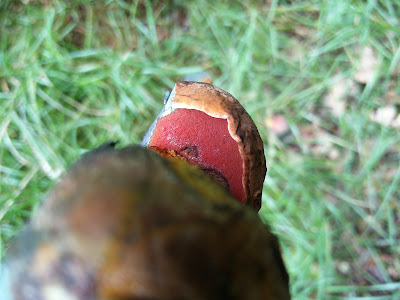I've been fancying doing this walk for a while, ever since I read about it in that fabulous publication: The Butterflies of Sussex.
This bolete was a new one for me.
It quickly turned a striking shade of blue, upon being cut...
... in the stem, as well as the cap.
And underneath the cap: SCARLET pores.
Using the key in Geoffrey Kibby's British Boletes, I make this one Scarletina Bolete Neoboletus luridiformis – a fairly common species. But what a stunner.
Next to the footpath that runs along the northern edge of Eridge Old Park, I spotted this mushroom sprouting out from a rotting log...
... providing food and shelter to this rather handsome slug.
I thought it was probably a Deer Shield Pluteus cervinus, so took a small section of the cap to check for the 'horned cystidia' which are characteristic of this species.
Here is a shot of one of those 'horned cystidia' under the microscope. I think this confirms it as Deer Shield Pluteus cervinus.
 |
| Mounted in water. 400x magnification. |
Nearby we spotted this stunning slime mould crawling over a pile of rotting wood. I think this is White Coral Slime Mould Ceratiomyxa fruticulosa.
A little further along I came across this lanky thing, growing up through the grass as the side of the path. Hard to believe such a slender stem can support that broad cap.
It's a little difficult to make out from this quick snap, but the cap is rather wrinkled; like the skin is slightly too big for the cap. The wrinkles are distributed radially: spreading out from the centre like spokes on a wheel.
Underneath, it has rather distant white gills.
I think it's probably Rooting Shank Xerula radicata. I did contemplate digging it up to see if it had the characteristic long rooted stem. But it looked so pretty I decided to leave it.
A big fallen Beech was hosting a large crop of oyster mushrooms Pleurotus sp.
Reflecting on Ted Tuddenham's advice following my Pleurotus find the other week, it's probably the Oyster Mushroom Pleurotus ostreatus. But P. ostreatus, and the complex of species around it, can be very variable and microscopy is often required to be sure. So I think I'll stick with Pleurotus sp. to be on the safe side.
In Whitehill Wood, I passed more dead and blackened remains of Spindle Toughshank Collybia (Gymnopus) fusipes, popping up around the roots of the oak trees – like I'd seen in Frith Wood the week before. But there was also this fresh cluster emerging.
A pile of decaying Beech logs produced a few other species.
I think this is Small Stagshorn Calocera cornea.
This got me stumped:
 |
| Fruit bodies growing out of the cut end of a large Beech log. |
 |
| One of the fruit bodies: upper side. |
 |
| One of the fruit bodies: underside |
For the record
Date: 23/07/2017
Location: Eridge Old Park and Whitehill Wood near Frant, East Sussex
Grid reference: TQ5835 (N. luridiformis, C. fusipes); TQ5734 (P. cervinus, C. fruticulosa, X. radicata?, Pleurotus sp.); TQ583350 (C. cornea, Polyporus sp.)
Records entered into FRDBI 06/09/2018













No comments:
Post a Comment